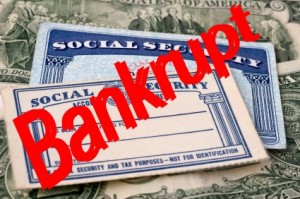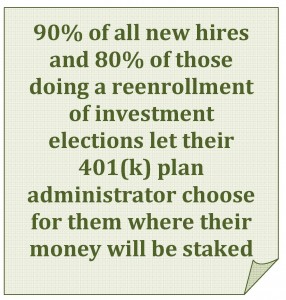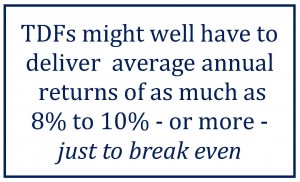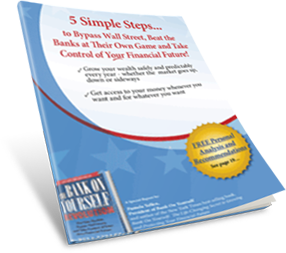By Pamela Yellen and Dean Rotbart
SANTA FE, NM – Officially, neither the U.S. government nor the retirement planning industry keeps count of how many American employees entrust others to decide for them how and where to invest their hard-earned retirement savings.

Nonetheless, there is evidence that the number of these so-called ‘zombie investors’ – those who shuffle forward without using their brains – may already exceed 15 million individuals and is on a sharp upward trajectory.

The march has been fueled by a Greek chorus of government regulators, Wall Street executives, financial planners and media commentators who regularly opine that only by delegating the task of retirement investment to others can individuals assure the optimal long-term preservation and appreciation of their nest eggs.
“Effective management of a retirement portfolio can be a challenging task, requiring significant knowledge and commitment of time,” cautions the Securities and Exchange Commission.
Thus the SEC and the Department of Labor have instructed employers to offer their workers a variety of defined contribution retirement plans, most commonly 401(k)s, “designed to make it easier for investors” to avoid the headaches and inherent risks of managing their own retirement monies.
Easier, indeed! But wiser and less risky? Often not
Such full-faith reliance on administrators and funds managers is propagating gargantuan portfolio losses that could billow to hundreds of billions of dollars during the lifetimes of the current generation of U.S. workers.

Already many Americans believe that by the time they retire the Social Security system will be bankrupt.
But what wage-earners have yet to comprehend is that many of the personal retirement accounts they are paying into annually at work will – regardless of how the markets perform over the
coming decades – stealthfully bleed each employee of tens of thousands, even hundreds of thousands of dollars that could remain theirs
The $64,000 Question
Consider the financial fate of an unaware 30-year-old worker who has relegated the choice of which investments should be selected for his or her present-day 401(k) plan balance of $25,000. Simply by allowing the plan administrator to choose a fund with annual fees of 1.5 percent rather than 0.5 percent – a mere 100 basis points difference – the employee stands to forfeit $64,000 or more in realized savings by age 65.
In fact, the $64,000 bite is a very conservative projection because it assumes the employee never contributes another dime to a 401(k) and also assumes the initial 401(k) does not suffer a significant loss of principal, such as the pruning that virtually all 401(k)s experienced in 2008.

If that same 30-year-old employee continues to add funds decade after decade until retirement – a fairly typical scenario – then the choice to assign the selection of 401(k) plan investments to his or her employer might easily deprive that 65-year-old retiree of $500,000 or more in late-life savings.

The 15 million or so employees who have already unthinkingly given over the selection and responsibility for their retirement portfolio to others likely have little or no clear knowledge of whose hands they have invited into their wallets or how dexterous these trustees are.
Those making the decision of where an employee’s money should be funneled could be well-qualified and specially trained financial planners. Or, because there are no prescribed standards for who is permitted to make these judgments, employees may be entrusting the most important financial decision of their lifetime to their boss’s dunderhead brother-in-law.
Does this process and the associated losses snowballing into the hundreds of billions of dollars seem scandalous? Does it seem like the government ought to step in and act?
Well it has. In 2006, as part of the Pension Protection Act, Congress approved legislation that shields companies and their 401(k) administrators – including the employer’s idiot brother-in-law – from liability should some of these millions of zombie investors one day awaken to realize just how efficiently their financial flesh has been ripped from them and consumed.
Despite the ghoulish financial consequences, most zombie investors don’t realize – and may never realize – just how lavishly their passivity is priced.
Invest It and Forget It
Government and industry statistics reveal that about 50 million Americans participate in employer-sponsored defined contribution retirement plans.

On the face of it, 401(k)s have it all – matching employer contributions, tax deferments, professional administration and fund management. In other words: invest it and forget it.

Why wrestle with the onerous, time-consuming, risk-prone task of managing one’s own retirement financial planning when it is possible to simply push the “autopilot” button and check back again in two or three decades to see how large your financial stockpile has grown?
The 401(k) industry has made the process such a no-brainer that employees need not bother to even select the type of 401(k) fund where their money will be invested. Rather, increasingly employees are automatically enrolled in one of three types of funds – technically dubbed QDIA or qualified default investment alternative – that the Department of Labor deems suitable for capital preservation and/or long-term capital appreciation.
According to Towers Watson, a global risk and financial management consultancy, 90% of all new hires and 80% of those doing a reenrollment of investment elections let their 401(k) plan administrator choose for them where their money will be staked.
Of those who opt for the no-brainer – i.e. “zombie” – method of retirement planning, roughly 70% end up invested in so-called Target Date Funds (TDFs), the most popular by far of the three QDIA types.

Since their inception in 1993, TDFs have grown exponentially and now account for about $270 billion, or roughly 10%, of all 401(k) assets. The funds attracted $43 billion in net new cash flow in 2009 alone and by some estimates may reach the $1 trillion level in 2014.

Individual investors and 401(k) plan administrators alike are drawn to the theoretical simplicity of TDFs. The concept: select the target date of one’s retirement, say 2025, and match it to a fund designed to grow increasingly conservative as the fund approaches its eponymous calendar year.
If TDFs work according to plan, their fund managers invest in stocks, bonds, cash and cash equivalents in proportions that are rebalanced over time in order to preserve invested capital and gains as the funds approach and pass the target date. A young employee’s TDF, with a target date 30 or 40 years out, would start off disproportionately favoring stocks, for example, and then five or ten years before retirement reallocate the mix of holdings more heavily toward credit-worthy bonds and cash or cash equivalents.


But contrary to their billing, TDFs proved highly unreliable in 2008, when funds with a fast approaching target date of 2010 suffered losses averaging almost 25%. At least one of 31 theoretically “safe” 2010 target date funds plunged 41%.
The fact that TDFs failed to prevent the portfolios of expectant retirees from evaporating so rapidly caused the SEC, Department of Labor and Congress to make quite a fuss, holding hearings and earlier this year proposing new SEC rules aimed at providing investors a better understanding of the risks associated with TDFs.
But for all the Sturm und Drang, Congress and the regulators have yet to propose modifying the rules that permit anyone whatsoever to serve as an employer’s 401(k) plan fiduciary. And astonishingly, no government body is promulgating new rules aimed at capping the wide-ranging fees charged by administrators and fund managers – fees that actually are the most risk-laden aspect of TDFs and all 401(k) funds.
Catatonic Investors and Double-Barreled Illusions
At least when investors opened their 401(k) statements in 2008 and 2009, they knew they had been sucker punched and hence had the choice to rethink the wisdom of TDFs – and for that matter, 401(k) plans in general.

But TDF and 401(k) fee creep is covert. Disclosure seldom reveals the true, compounded costs of higher fees paid out over decades. Nor do most disclosure statements break out the entirety of fees, including those paid to plan administrators, to fund managers and, in echoing fashion, to the funds that those managers reinvest in.

The visible and hidden fees ripple along until the charges, paired with taxes and loss of buying power due to inflation all but consume a retiree’s full capital appreciation.
Here is the reasoning. If the complete buffet of TDF costs and fees total an average of 2% annually (which most likely is a conservative number) and inflation averages 3% annually over the decades a 401(k) plan is in place, then a plan participant has to generate a 5% average annual return just to preserve his or her invested principal.
But even 5% doesn’t clear the hurdle. Why? Because taxes on 401(k) principal, matching funds, interest, dividends and gains are deferred – not eliminated. Factor in future taxes, which could be assessed at rates higher than they are now, and TDFs might well have to deliver average annual returns of as much as 8% to 10% – or more – just to break even.

TDFs, it turns out, are the elite of the zombie 401(k) guard, leeching payments from catatonic investors with a lethalness and efficiency that even horror filmmaker George A. Romero, director of the 1968 cult classic Night of the Living Dead, never conjured.

In his book, Common Sense on Mutual Funds, John Bogle, founder and retired CEO of The Vanguard Mutual Fund Group, writes: “The largest target-date funds include only the costs of their underlying funds in their expense ratio, the range of those costs runs from .18 to .86 percent. Shockingly, however, more than half of the target-date funds carry their own hefty expense ratios – in addition to the expense ratios of the underlying funds, usually in the range of .70 to 1.30 percent. Together these costs can reach almost two percentage points, paid year after year.”

Because payroll withholdings invested in a TDF are compounded, as are appreciation, dividends and interest on the principal, even small 401(k) contributions can grow impressively large with the passage of decades.

Such compounding creates two costly illusions for unsophisticated 401(k) plan participants.
First, even a modest amount of appreciation on principal can seem like quantum growth when amplified by time and compounding. In our original example above, which is taken from a Department of Labor illustration, $25,000 untouched for 35 years in an employee’s 401(k) account will grow to $227,000 at retirement, assuming an average annual return on investment of 7 percent and fees and expenses of 0.5 percent.
Seems pretty nifty on first inspection. Twenty-five thousand dollars transmutes into more than 10 times that amount, no brains required.
The second illusion pertains to fees and expenses, which also balloon courtesy of time and compounding. To an investor who has passively watched his or her $25,000 multiply by a factor of ten or more, the imposition of a tiny 0.5% (half-of-one-percent) charge for fees and expenses often seems like a drop in the bucket.
But turn up the lights and what is revealed is a tsunami of funds, accumulated over a lifetime of labor by an employee, being summarily washed away due to dimwitted administrators and rapacious fund managers.

Even assuming that our 30-year-old employee had no better savings options in return for his or her 35-year net gain of $202,000 – an unduly generous assumption – the unsuspecting wage-earner will have paid a stunning $39,915 in fees and expenses.

That “tiny” 0.5% charge actually dispossesses our 30-year-old TDF investor of 19.76 percent of his or her entire retirement nest egg.
Worse, many TDFs charge fees and expenses in the 1.5% to 2.0% range – all, recall, with the blessings of the Department of Labor and sanctuary from liability.
Rerun the numbers and when the fees and expenses amount to 1.5% instead of 0.5%, the total sweep of the retiree’s savings cascades to $103,914 or 38.93 percent of his or her retirement nest egg.
This calculation bears repeating: annual fees amounting to only 1.5% will flush away nearly 39% of an investor’s entire life-long 401(k) savings.
That is quite the disappearing act, but no illusion.
The No. 1 Fallacy of Investing
The answer for zombie investors, and those who want to avoid the designation, is not to assume sole responsibility for their retirement savings – but to assume at least some responsibility.

Redemption lies in knowing in as much detail as possible what retirement plan options are available and what fees they entail. No one should automatically decide for a 401(k) participant where to invest. Seemingly safe and well-performing retirement funds, such as TDFs, may be neither safe nor efficient.

Before making their own choice, employees should investigate alternative retirement savings vehicles with the realization that funds such as TDFs that are a la mode and come highly recommended may favor the retirement planning industry more than retirees.
Because of compounding, keeping fees in check will likely have greater influence on how much money individuals have to spend in retirement than the underlying performance of the funds they invested in – assuming they invest in any of the government-approved QDIA funds, or like alternatives.
Remember, the number one fallacy of retirement planning is that it is safe to entrust your ultimate success to anyone but yourself.
Note: The references and sources used for this article, along with additional resources, are available here.
October 1, 2010
About the Authors:
New York Times bestselling author Pamela Yellen is the originator of the life-changing Bank on Yourself system and related personal finance strategies. Pamela has worked as a consultant to successful financial advisors for more than two decades.
Pulitzer Prize-nominated investigative reporter Dean Rotbart has reported on business and financial topics since 1979. His editorial and research clients include numerous Fortune 500 companies and leading communications agencies.
© 2010 Hayward-Yellen 100 Ltd Partnership


There are fees for investing in an IRA, 401(k) or a retail account. Fees paid by small company 401(k) participants are the approximately same as those paid by IRA investors and retail investors with similar investments. The world’s lowest investment fees are one of the benefits of investing in a large company 401(k). This holds true for target date funds which provide a duration sensitive, diversified portfolio that is periodically rebalanced–all excellent long term investment practices.
David Wray
President
Profit Sharing/401(k) Council of America
As you noted, large company 401(k) participants generally pay lower fees. But the bulk of employees work for small companies whose fees are higher – sometimes much higher.
And I maintain that target date funds are way too costly, especially given their overall performance, risk and complexity. As John Bogle (Founder of Vanguard Mutual Funds) noted in his excellent book, “Common Sense On Mutual Funds,” more than half of target date funds “carry their own hefty expense ratios – in addition to the expense ratios of the underlying funds. Together, these costs can reach almost two percentage points, paid year after year.”
And that’s just the mutual fund expenses!
I appreciate the good work your organization does, but I think there’s more to this story than meets the eye.
There are lots of reasons why the 401k is a non-starter for me. And any one of them is enough for me not to do it.
1. Someone’s making money from me whether I make money or not. I’m happy to pay for a job well done. But that’s not who or what you’re paying for.
2. I don’t have immediate access to my money.
3. I don’t even have an expectation of getting my money in some reasonable time, especially in an emergency. (It took Fidelity 3 years to transfer a 401k after a divorce. And even then they wouldn’t do it. I had to close the account, pay the taxes, and then transfer the cash, all for arbitrary policies within Fidelity). The same is true for a bank. If you wanted to get, say, $25,000 out in cash you’d have to make an appointment and come back in a week. But at least they won’t give you the runaround. It’s your money and they will give it to you.
4. I don’t trust any of them. They have shown themselves to be self-serving and obfuscating. They have infiltrated the regulatory agencies and no one seems to have the courage to put them in line. And the population in general has swallowed the line that giving strangers lots of money for decades is a good idea. So it’s not likely there will be any political momentum to change.
5. It is nothing short of pure gambling. You’re sending money into a black hole, from which much of it may never return. And you have no recourse or hedge. It is literally a sham. No one knows the future. More importantly, no one knows what they’re doing. And you want me to give my money to them?
6. 30 years (or more) is a long time.
7. I don’t care as much about inflation on my cash as I would about volatile stock prices, fees, changes in tax law, economic crises, wars, and whatever else would make such a leap of faith nerve wracking for 30 years.
8. Gold? Are you kidding me? Some equally arbitrarily priced metal that looks pretty? Can I feed my goats with that? ( I don’t actually have goats, I’m just sayin’ ) Gold is like the stock market for rebels and anarchists, or those afraid of anarchists. Same story. Actually, it’s worse. You generally won’t even get the gold! You get a certificate! What?? (I know, not relevant)
9. The fact that everyone and his brother thinks that 401k is a no-brainer is a sure sign I should be doing something else. Following crowds is not a path to success, enlightenment or fulfillment, let alone a comfortable retirement.
10. I don’t live in a cabin in Montana and don’t have a manifesto about the evils of technology. But snake oil salesmen can talk to the hand.
How about keeping the money you make? How about living within your means? Ok, life is expensive. Maybe you had to borrow money for this or that at one stage in your life. Pay it off. Get yourself, over time, to a place where you keep more than half of whatever comes in. And really keep it. Don’t give it to some schmuck in New York. Put some in a local bank that you trust. Find out what their policies are and how quickly you could get your money out if you had to. Also, maybe get yourself a big, heavy, fireproof safe and bolt it to some concrete or something and put some emergency cash in there. What happens if an earthquake or small nuke takes out the electrical grid? How do get cash? What if you can’t use a credit card? In short, be what an American is supposed to be; self-sufficient.
Kevin, you NAILED it!
It doesn’t sound like you’re aware of my favorite place to store your money – learn more about the Bank On Yourself method here.
[…] (The 401(k) reality, as I frequently point out, is seldom as neat and efficient as the vow. Read the shocking exposé I co-wrote with Pulitzer Prize-nominated journalist, Dean Rotbart: “More than 15 Million ‘Zombie Investors’ Unwittingly Allow Others to Feed Off Their Retir….”) […]
The 401k/IRA, ie: stock market scam…geesh, where to start….
I am a recovering “financial advisor” and once sold stocks, bonds, mf’s, LI,LTC, annuities, set up 401k’s, 403b’s..you name it, I did it.
Now, I am almost militant in my personal belief that what has been promoted to millions of Americans as the best and almost only way to save/invest for retirement is through the use of employer sponsored, tax deferred, stock market based retirement accounts is, probably the biggest scam ever perpetrated on the people. Perhaps by design?
The fact that millions would voluntarily contribute to accounts that will have at least 30% confiscated, and probably more is compelling. Also, contributing to an account that at a time in the future you will need to rely on this account to most likely be the sole provider of your livelihood and not have an inkling of how much will be in it is once again compelling to say the least.
The terms “save” and “invest” have been merged into the same definition in regards to what the said millions are doing with their retirement dollars and the results are in my opinion going to be catastrophic as many will fall far short of what they will need to adequately provide for themselves. Americans need to save for retirement and what they are doing instead is investing and or gambling. These monies HAVE to be there and when one has no idea of what the balance or spendable amount is going to be at a point in the future, it just begs the question of why are millions following this path.
The answer is two pronged and to a large degree the trillions that are generated and WS companies that are benefiting have huge marketing budgets to continue this charade. The other side is that the government is in cahoots with WS in that govt is happy to give us a tax break on contributions today for what they see as future revenue streams from millions of accounts.
It is a national disaster and calamity of epic proportion barreling down on us. I have other ideas as to why this has been allowed to happen but that is for another website!
I am a BOY and Inifinite Banking disciple and participant and finally feel that I have control over where I will be account balance wise down the road and that is a good feeling.
I may in the future get back in the financial services game and if so, it will be to do nothing but sell big life policies with the BOY/IBC concepts as the basis for the policy. Interestingly, for a time in the financial services business I worked the LEAP concept but never was the financing component and PUAR ever utilized! I believe it to be the strongest component of the program! Bob Castiglone could learn something from BOY!
BTW, it was the BOY ad I heard on radio that caught my ear and started me down the path.
thanks for bringing the whole life policy back and out!
Dave Wilson
Hi Dave,
Well put! I couldn’t agree with you more.
~Pamela
Hi Pam, I have been checking out your BOY for the last couple of months now. It is something I am going to start real soon.Why do you suggest using whole life? It seems like there are some universal policies that are better than this whole life policy. Why are you such a big advocate of whole life? Thank you, Scott.
No other type of life insurance product comes with as many guarantees as whole life insurance. The ONLY piece of a dividend-paying whole life policy that’s not guaranteed is the dividend.
The more I learn about universal life policies, the less I like them.
Why the heck would anyone want to take a guaranteed product like whole life and muck it up by adding in an investment component anyway? Most Americans are already gambling too much of their nest-egg in the Wall Street Casino.
I think the problem is that most insurance agents don’t truly understand how universal life works. I encourage you to read these two non-biased articles comparing universal life and equity-indexed universal life to whole life, and then come to your own conclusion:
Equity Indexed Universal Life versus Dividend Paying Whole Life
Whole Life Insurance vs. Universal Life Insurance
I hope this helps!
why does the whole life policy have to be policy holder owned ins company instead of a stockholder owned company?
The first reason is that companies owned by policy owners, rather than stockholders/investors, allow the insurance company to focus on the long-term interests of policy holders instead of the short-term demands of Wall Street.
The second reason is that mutual companies typically offer the policies that meet ALL the requirements needed to maximize the power of this concept.
Hi Pam, is it relatively easy to borrow money from your policy and does it take very long to actually receive a check from the ins company? I have previously heard from people it is a pain trying to get money from a whole life policy. Thank you, Scott.
It’s not a pain at all! Depending on the company and the amount, you’ll typically have the money within days by calling or faxing in a one page request. Some companies will offer various options including wire or ACH transfer the funds, overnight a check or mail it.
I’ve taken DOZENS of policy loans and never once had a hang up or delay.
I second that Pam. I too have taken loans on different policies of mine and all very easy with little to no delay.
Interesting point….in these days of low rates and a seemingly high desire for housing market to turn around and billions of dollars of liquidity…my wife and I are having to jump through incredible hoops to refinance primary and rental properties. Not even new money am I asking for just a desire to renegotiate terms of already loaned money..with the same company!! Point is…you never have to prove anything to the insurance company to get the money.
You got it, Dave! Dividend-paying whole life is about guarantees, predictability AND control! With Bank On Yourself you set the terms!
Hi Pam, I just finished your book. Once I started I couldn’t put it down. I was going to start the Bank On Yourself method this past April but a once in a lifetime house came up so we jumped on it. It is complete with a pool and theater room. With the bad economy, we caught a break on a foreclosed house. I am ready to get back to this again with our house all taken care of, especially after reading your book.
I came up with many questions which I will save most for my advisor. My main question is this: we really don’t purchase vehicles very often because I believe in driving vehicles until they either cost too much to fix or drive until they are completely dead. You said in your book that we should borrow money because it grows your nest egg quicker. Would it be smart to just borrow say $10,000 or so just for the heck of it to make the money grow quicker? It was noted that you should borrow money because you would be better off. Sorry for being so windy but your book has me revved up. I will tell others about the book.
Hi Scott,
You have a little confusion about this. Please re-read pages 100-103 of my book for a better understanding.
Pam,
wanted to get your thoughts on the concept or feasibility of using the BOY concept, utilizing whole life policies as ones sole retirement/financing vehicle. Do you think, particularly if one started very early and committed all retirement dollars to this could it solve for retirement? Assuming company solvency and steady dividend participation.
Dave W.
As I’ve said many times, none of the other 450 plus financial products and vehicles have come close to equaling the advantages and guarantees of Bank On Yourself.
A young person who saves enough for their future in a Bank On Yourself policy can virtually assure they’ll retire a millionaire (my nephew is a great example of that).
An older person funding it with sufficient funds could do the same.
Every person’s situation is different, and I’m an educator, not a financial advisor, so I don’t make specific recommendations.
But keep in mind it DOESN’T have to be an either/or situation. Many people use their cash values to invest in other things – I have several chapters in my book of interviews with people who do that in many different ways.
I just received an email from someone yesterday who bought a share in a two year old thoroughbred horse that will run at the Hollywood race track, using his Bank On Yourself policy.
If the horse wins some money for him, his policy is working him in two ways at the same time, because he’s continuing to earn the same interest and dividends on the money he borrowed.
I heard it put this way recently:
Does having money safe and available to you when you need it (as with Bank On Yourself) take away any of your options?
I hope this explanation helps.
Thanks Pam. I too think if utilized properly the BOY concept and a good quality participating, properly funded policy can provide for all of ones financial needs.
I also agree that the funds can be used for outside investment. I recently used $15k and doubled it in gold. Now that is speculation which I am not a big fan of but I had some dumb luck.
I have also used funds for down payments on rental properties, which I am setting up to be my pension…since pensions are a thing of the past and we cant depend on SS to be there. Properties slated to be paid off in 20 yrs will provide ~$7500-$10k per month. They will provide deductions to offset income.
Walt Disney utilized his cash value after being turned down by conventional loan institutions and created his fortune.
Hi, I spoke to an insurance representative about BOY today and she claimed agents do not take a 40% pay cut for selling this type of insurance. I dont think you would say this if it werent true. Any idea why she would say this?
Actually, the insurance rep you spoke to was right – the Bank On Yourself Authorized Advisors do not take a 40% pay cut – they take closer to a 70% pay cut!
Why would she tell you this? I can think of two reasons:
1. She herself is not willing to accept a 70% pay cut.
2. Even if she were willing to accept a pay cut, she has no clue how to structure a policy the Bank On Yourself way, which grows your cash value much faster, at the expense of the agent’s commission.
You initially were referred to a Bank On Yourself Authorized Advisor who is extremely knowledgeable about this concept and would be happy to structure your policy correctly.
I strongly urge you to get back in touch with that Advisor today, so they can help you set this up properly. If it is set up wrong (by an agent not willing to accept the commission pay cut), your cash value will grow much more slowly. Is that what you want?
http://www.marketwatch.com/story/very-slow-growth-2012-then-long-bear-to-2020-2011-11-22?pagenumber=2
Great article. The facts of which I have been blogging about for a few years now. It has been a national/systemic brainwashing of the American investing public. The stock market and Wall Street are not, and were not designed for mass retirement savings. “Savings” means just that…save….
Thank God for the BOY program coming to my attention. I was actually using whole life policies for the basis of my retirement but they were not set up properly. I actually took a hit and did a 1035 exchange into a new, properly structured whole life plan with a BOY trained rep.
My plan started with a $50k 1035 exchange from old WL plan. Now, with a $500 a month premium, PUAR of $3800 a year, dividends staying at current levels projected out 20 yrs….I have cash of almost $500k..which is tax free. I’ll take that any day of the week over the hand wringing of stock market, tax deferred, govt sponsored retirement accounts.